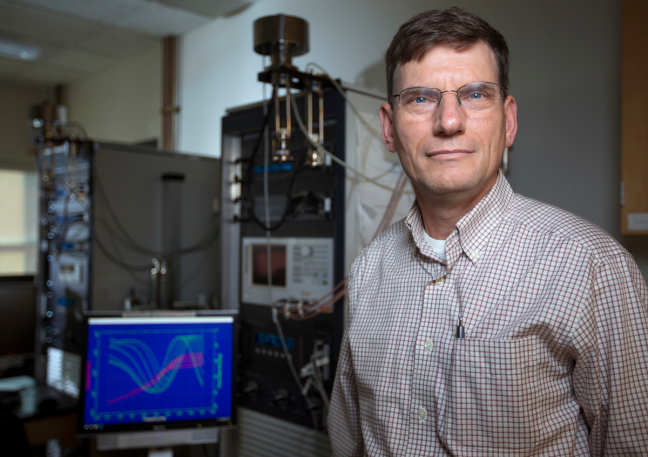
ECS member Steve Martin receives a $2.5M grant to pursue research in glassy solids.
Image: Christopher Gannon
The world relies on battery power. The smartphone market alone – which is powered by lithium-ion batteries – is expected to reach 1.5B units in 2016. ECS member Steve Martin believes he may be able to take those batteries to the next level through efforts in glassy solids.
Martin, a professor at Iowa State University and associate of the U.S. Department of Energy’s Ames Laboratory, has been in the field of battery research for over 30 years. Throughout that time, his main focus of research has shifted to measuring the basic properties of glassy solids and trying to understand how their ions move and the thermal and chemical stability.
Martin believes that using glass solids as the electrolytes in batteries would make them safer and more powerful. This is an effort to diverge from traditional liquid-electrolyte batteries, which have experienced issues with safety and energy capacity.
To push this research, Martin recently received a three-year, $2.5M grant from the DOE.
“This is my dream-come-true project,” Martin says. “This is what I’ve been working on for 36 years.”
This from Iowa State University:
Battery electrolytes allow ions – atoms that have lost or gained electrons and are therefore positively or negatively charged – to flow back and forth between a battery’s electron-accepting cathode and electron-losing anode. The resulting electrochemical reactions produce electricity and power our devices and electric vehicles. Commonly used organic liquid electrolytes in lithium-ion batteries are a problem, Martin said. They’re as chemically reactive as gasoline and so they can – and do – catch on fire. Batteries based on them can also leak the flammable liquid. To make them safer, manufacturers slash the energy levels of the batteries.
“It works,” Martin says. “But it operates at a fraction of its theoretical maximum energy density.”
The challenge lies in understanding how to move ions through solids. Through the use of certain sulfide glasses, Martin has been able to accelerate movement. The new grant will allow glassy solids to prove the wroth in cost, performance, stability, and safety.
“And so maybe you’re recharging your device every week instead of daily,” Martin said. “Or maybe an electric vehicle that can now go 40 miles on a charge will be able to go 200 miles.”

